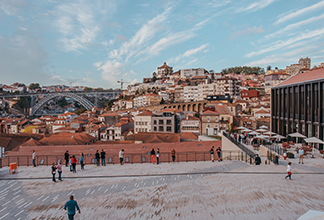
Bacalhau – or salted codfish
Bacalhau - or salted codfish - is definitely one of the most popular and well known dishes among Portuguese cuisine. The codfish is dried and salted, like in olden times, to preserve it and this way it will keep for longer out of the fridge in a larder, wrapped in thick paper, or frozen, if pre-soaked to remove the excess salt. Since fishing is a big part of Portugal’s heritage, the preservation of codfish was an advantage when there was an abundance of fish. Nowadays, there isn’t such abundance; however, the salt also brings out the flavour more than if it were fresh codfish.The saying goes that there are 365 different ways to cook ‘bacalhau’ – one for every day of the year. The method you choose and the ingredients depend on your taste, but you will easily find these well-known dishes on restaurant menus. Take for example ‘bacalhau’ roasted in the oven with onion rings, olive oil and garlic ("à Lagareiro”), often served with potatoes baked in garlic and olive oil called ‘batatas a muro’ or ‘punched potatoes’. Alternatively, baked in the oven with a creamy béchamel sauce and fried potatoes (‘bachalhau com natas’), or fried with potatoes, onion and scrambled egg (‘bacalhau a bras’) or ‘bacalhau a Gomes de Sá’ sautéed with boiled potatoes, eggs and onions are just a few of the many combinations. Sometimes the fish is prepared as a piece of salted cod fillet and in other dishes, the fish is flaked and transformed into a special fish pie often completed in the oven. A simple way that the Portuguese like to eat salted codfish is, for example, at Christmas when it’s steamed and served with cabbage, boiled eggs and other vegetables.
You will find ‘bacalhau’ served in many restaurants in Portugal, as well as in Portuguese homes. If it’s your first time here, it’s a good idea to try some as it can be quite delicious. For others, it can also be an ‘acquired taste’.
Sardines and other fresh fish and seafood
Due to Portugal’s position on the Atlantic coast, fishing is a natural source of income and fish here will be some of the best you’ll taste in Europe. The grilled sardine is full of flavour and being readily available, it’s an inexpensive option. Sardines are traditionally served at festivals, barbeques and in beach restaurants, including the famous São João festival in Porto which takes place on the 23rd and 24th of June each year, when they’re served with potatoes and grilled peppers.Apart from the famous sardine, there’s a huge variety of fresh seafood readily available in Portugal, making it less expensive than in other countries, such as cockles, mussels, crab and prawns in various sizes. Clams are also popular and used in many well known Portuguese recipes. You can also readily find sea bass, sea bream, stone bass and plenty of other fresh fish, and although these are usually more expensive options, they are delicious when freshly grilled with salt, garlic and a little olive oil, or sometimes prepared in more sophisticated sauces depending on your choice of restaurant. Octopus, squid and hake, such as fillet of hake fried in beaten egg (filetes de pescada), boiled or roasted octopus (polvo) or fried or braised squid (lulas), are also very popular. These are usually served with either boiled potatoes, chips and salad, or typical Portuguese rice.
Cozido à Portuguesa
Translated, this dish means Portuguese boiled stew - and for many, it’s considered to be the most traditional dish of all. There are many different ways to make it and these vary from region to region, although the ingredients are usually based on: beef, pork, chicken and sausages, with beans, chickpeas, potato, turnip, cabbage, carrot and rice. The meat is boiled with very little fat in various stages of broth with the vegetables, and the meat and vegetable stock is kept to cook the rice in at the end. It’s a flavoursome dish and in spite of all the ingredients, is fairly light on the stomach due to the boiling and steaming of the meat and vegetables (depending on how much you eat of course!). It is a lengthy dish to prepare though, and is often kept for special occasions, or for traditional family Sunday lunch. It is also common to find it on Portuguese menus in restaurants.Leitão (Suckling pig)
The Portuguese love pork dishes and whilst one will usually find several on any menu in Portugal, from cubes of pork fried with clams or chestnuts, to simple roast leg of pork, for most people the favourite is ‘leitão’, or roast suckling pig. This dish is served throughout Portugal and is popular at weddings, but the most famous region of all for this dish is Bairrada, and in particular, a small town called Mealhada. The most traditional method involves roasting piglets weighing between 6kg to 8kg that have been reared on acorns. The meat is rubbed prior to cooking with garlic, pork fat, rock salt and pepper and then slowly roasted on a spit for about two hours, with constant basting, often inside wood burning stoves using scented wood such as eucalyptus and vines. The result is succulent, moist meat with crispy skin and if you try this dish in Bairrada, where the famous Baga grape comes from, then you can also accompany it with a glass of red wine from the region.Caldo verde and other soups
Soup can be found on all Portuguese menus as Portugal grows many vegetables – and very tasty ones at that - and it is frequent to enjoy soup daily in this country, mainly as a starter. From cream of vegetable soups to chicken and pasta, gazpachos to shredded vegetables in consommés, there is an enormous variety on offer, dependant on the chef’s creativity and local tradition. One very famous Portuguese soup is typically from the north of Portugal, although it can be found on menus all over the country. It’s a green cabbage soup called ‘caldo verde’, made from a thick, creamy base of onion and potato with dark green, very finely shredded cabbage and slices of sausage. It’s a hearty, warming soup, enjoyed at parties and festivals and often equated with rural areas. It is appreciated by both the young and old.Francesinha
This dish is fast becoming a modern classic and one that originated in the north of Portugal in the 1950’s to 60’s and has become equated with Porto. The francesinha or ‘little Frenchie’, is a large layered sandwich usually made with steak, ham, sausage and sometimes egg and bacon, covered with a thick layer of melted cheese and a sauce made from tomato, beer and chillis. The idea came from the original French croque monsieur but was adapted by the Portuguese to their culture and taste. The tangy sauce gives the dish some extra bite and it can be served with fries. Both adults and children enjoy a francesinha as the sauce isn’t usually very spicy. There is a lighter sandwich version in a toasted baguette, in which you have similar ingredients, but not usually the steak. It has a light spreading of sauce on top. Both versions are definitely worth trying.Ameijoas à Bulhão Pato
Another famous seafood dish is Clams prepared ‘Bulhão Pato’ style. It is a typical dish in summer as the clams are steamed in a light broth with olive oil, garlic, white wine, coriander, lemon and pepper, but it is also found on menus all year round and can be eaten as a starter or main course. To prepare the sauce, garlic is fried in olive oil to which coriander and lemon is added and white wine. The clams are then steamed in the broth until fully opened. This dish is a favourite at beach restaurants where the casserole is usually brought to the table for serving along with plenty of bread to soak up the juices.Feijoada
The main ingredients of feijoada are beans and pork and there are several versions. It’s a dish that may have originated from Tras-os-Montes and the Douro and requires using either red, white or butter beans. The pork is braised in a sauce with tomato, carrots and cabbage to which typical sausage meats and bacon are also added. The sauce thickens with the help of the beans and pork, making it a dish that is more appropriate to eat in winter than in summer. It is typically served with white rice.Alheiras
The Alheira is a prestigious Portuguese smoked sausage; its main ingredients are pork, poultry meat, breadcrumbs and olive oil, seasoned with salt, garlic and paprika. Game meat, beef, duck, pepperoni and cured ham can also be used. Horseshoe-shaped, the Alheira is made using a fine paste and minced meat which is then filled into either cow or pig tripe.Handmade in the northern region (Trás-os-Montes) and central region (Beira Alta), the Mirandela variety of the sausage is the most well known. Alheira sausages can be cooked on the barbecue, or fried in their own fat, or indeed par boiled and finished off in the oven. They are often served with rice or chips but more traditionally with boiled or sautéed vegetables.
The origin of the sausage dates back to the late fifteenth/ early sixteenth century, and is associated with the presence of Jews in Trás-os-Montes. Since they didn’t eat pork, the Jews didn’t make a traditional sausage and avoided smoking the meat, making them easily identifiable to the Inquisition. So, they decided to use other meats which they wrapped in dough to make the alheira. The recipe turned out to be popular among Christians who eventually added pork to the dish.

























